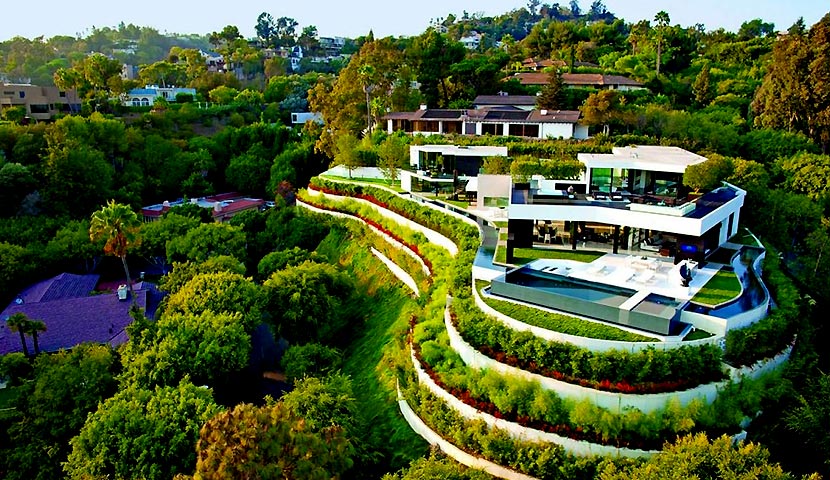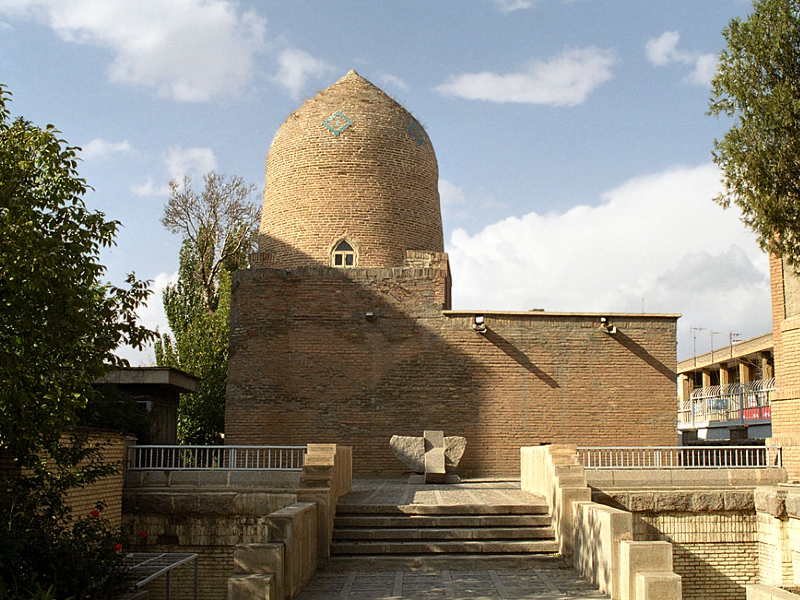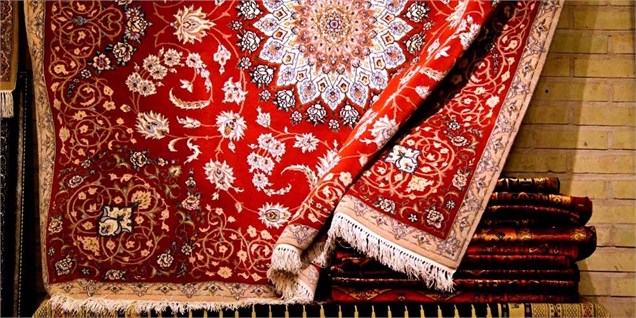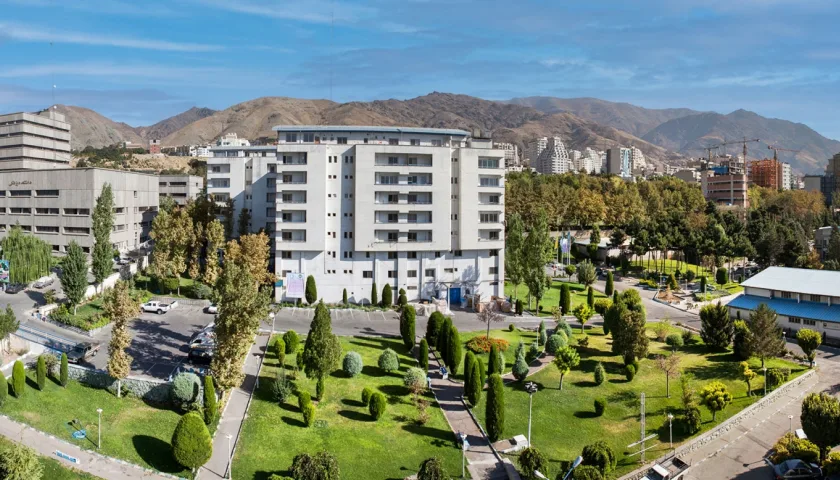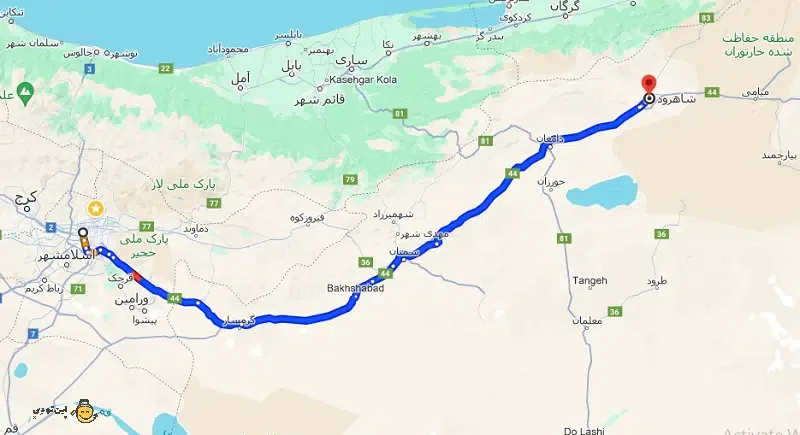Discovering Lavasan: A Hidden Gem Near Tehran
Lavasan is one of the cities in Shemiranat County, Tehran Province, which attracts many tourists thanks to its pleasant climate, lush landscapes, and natural attractions. Lavasan is divided into Lavasan-e Bozorg, Lavasan-e Kuchak, and Lavasan City, accommodating numerous villages within its vicinity. Situated near Tehran, this area allows the capital’s residents to escape the hustle and bustle of the city and immerse themselves in the beautiful embrace of nature within a short distance.
Get acquainted with the attractions of Lavasan:
Natural Attractions of Lavasan
Touristic Villages of Lavasan
Religious Sites of Lavasan
Historical Attractions of Lavasan
Other Attractions of Lavasan
Natural Attractions of Lavasan
Latian Dam Lake
Latian Dam is one of the lush picnic spots and nature destinations near Tehran, where the capital’s residents can enjoy a great weekend getaway without spending much time or money. Located 25 kilometers northeast of Tehran, along the Jajrood River, Latian Dam provides drinking water for the city. Fishing, hiking in the lush hills, and exploring the surrounding villages are among the recreational activities available in this area.
Naran Waterfall
Naran Waterfall, located north of the village of Kand-e Aliya in Lavasan-e Kuchak, has a height of 10 to 15 meters, with its water volume increasing during the spring season. This perennial waterfall shines like a gem amidst lush meadows, and its flowing water has carved beautiful grooves on the rocky cliffs. If you happen to visit this waterfall, there is a small pool at its base where you can take a refreshing dip. Since the area enjoys moderate weather during the summer, this season can be considered the best time to visit Naran Waterfall.
Havij Plain
Havij Plain, also known as Gorchal (Fire Pit), is considered one of the attractions of the village of Afjeh, seemingly named after the cultivation of carrots in the past. To reach this plain, after parking your car in the village, you need to take a steep and uphill path that passes through apricot, cherry, and walnut orchards along the way. After about two hours, you will reach this beautiful plain.
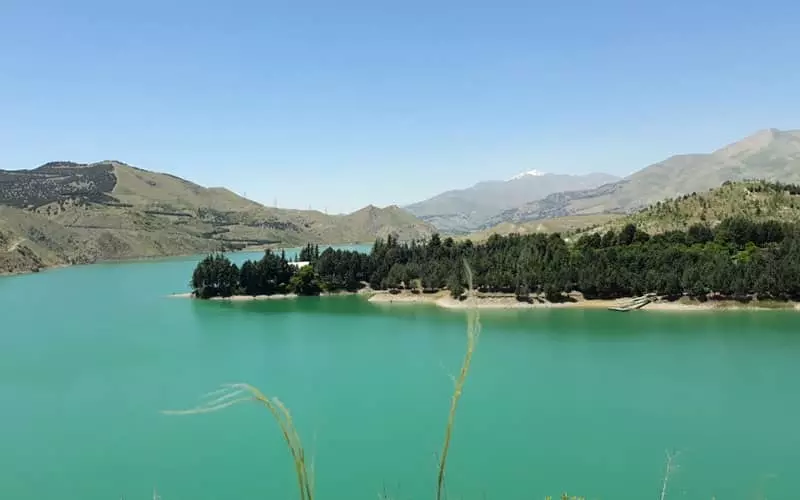
Natural Attractions of Lavasan
Kafterlu Waterfall
Kafterlu Waterfall is situated in a beautiful valley, 6 kilometers north of the village of Kand-e Aliya. To reach this waterfall from the village, you can either hike for about 1.5 hours or drive, although taking a stroll amidst the cherry and apricot orchards along the winding road would enhance the beauty of the journey. In the summer season, the shaded lanes of the orchards and their captivating beauty make this route even more appealing.
Bagh-e Jahan Waterfall
Bagh-e Jahan (World’s Garden), a picturesque village in the Lavasanat region nestled in the southern foothills of the Alborz Mountains, resembles a leaf shape. The beautiful waterfall is located approximately 2.5 kilometers from the village in a river valley that fills up significantly in early spring. To reach the waterfall, you have two options: one is by car, and the other passes through a beautiful garden lane.
Lokhmireh Cave
Lokhmireh Cave, also known by other names such as Lareh Prison or Rokhmireh, is located 2 kilometers northwest of the village of Bagh-e Jahan in the Lavasan area. This cave, with a length of about 30 meters, has dimensions of approximately 2 meters by 2 meters. Several small caves in this area catch the eye, often mistaken for Lokhmireh Cave. One distinguishing feature of the main cave is the prominent rock in front of it, which is not seen in the other caves.
Varjin Protected Area
Varjin Protected Area was designated as a protected area in 1982, with the main access route from Gerdneh Ghouchak in eastern Tehran (Tehranpars). This area is of great importance in terms of biodiversity, including central Alborz animals such as ibex, Persian leopards, wolves, brown bears, wild goats, and deer. The vegetation cover of the Varjin area also includes numerous medicinal plants such as hawthorn, asafoetida, yellow corydalis, wild rue, alpine vetch, fragrant violet, mountain savory, and more.
During the spring season, when animals such as ibex, Persian leopards, and deer give birth, it’s advisable not to travel to this area to preserve the tranquility of wildlife.
Tourist Villages of Lavasan
Afjeh Village
Afjeh Village is nestled in the heart of the mountainous nature, hence enjoys pleasant and appealing weather for most days of the year. This lush village boasts numerous springs, rivers, orchards, and farmlands, including apple, cherry, apricot, walnut, wheat, and barley orchards. A large river runs through the center of the village, irrigating the orchards and agricultural lands, with an attractive pathway along its banks for leisurely walks.
Paschuvik Waterfall or Paskouhak, standing at 15 meters in height, is one of Afjeh’s most famous attractions located northeast of the village. The freshness and lushness of this area, along with the presence of oleander trees, lend an extraordinary beauty to this waterfall. Upon reaching the top of the waterfall, you’ll be treated to a breathtaking view of Havij Plain.
Moab Waterfall, with a height of 180 meters, is another spectacular waterfall in Afjeh, located before Havij Plain. Tourists and hikers heading towards Havij Plain often take a break by this waterfall to enjoy its beauty.
Afjeh Village is situated on the route to peaks such as Saka, Mehrchal, Atashkadeh, and Glacier, and most climbers passing through this village.
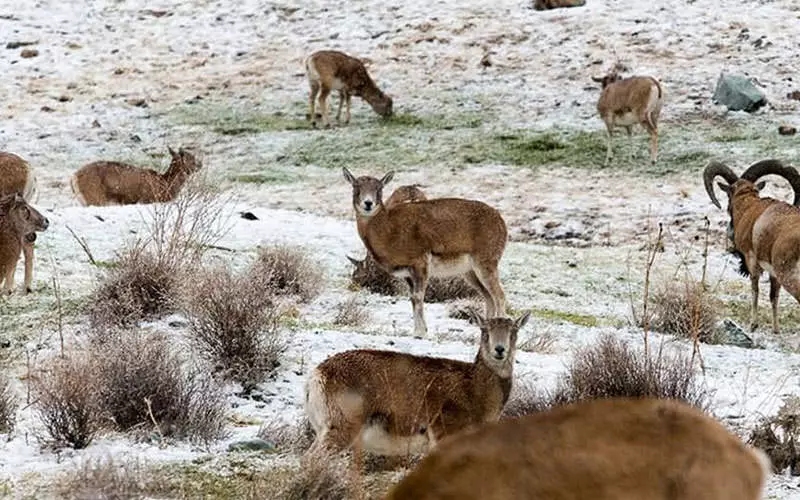
The historical bathhouse of Afjeh Village is also noteworthy, as it was built by the order of Shah Abbas and has been restored with renovated walls and floors. Interestingly, locals still use this bathhouse, albeit with some modifications, converting it into individual shower rooms. This site was registered as a national monument of Iran in 2003.
Kand-e Aliya Village
Kand Village is divided into two sections: Aliya and Sofla (Upper and Lower), with the Aliya section captivating every spectator with its beautiful gardens, orchards, and several roaring waterfalls, making it a perfect destination for a day trip for Tehran residents. There are numerous attractions in this area, including Gushvarah Hills, Pirzaneh Castle, Imamzadeh Mohammad Shoaib Shrine, and Shir Tazeh Hill. This beautiful village is particularly inviting during the spring and summer seasons, with its pleasant weather, especially when the cherry and apricot trees and lush gardens add extra charm to it.
Sink Village
Sink, a lush and verdant mountainous village with cool springs and abundant orchards of apples, cherries, apricots, and walnuts, is one of the famous highland regions near Tehran. It’s a great choice for leisurely strolls and hikes, especially during the spring and summer seasons when the landscapes of the village, particularly with its old-fashioned houses, captivate photographers and nature enthusiasts alike. Situated on the banks of a large river and in the foothills of steep mountains, archaeological excavations in this area indicate that Sink’s history dates back to pre-Islamic and Zoroastrian periods.
Religious Attractions in Lavasan
Imamzadeh Ismail (AS)
Imamzadeh Ismail (AS) is one of the 34 shrines in Lavasan located in the village of Bagh-e Jahan. The current structure of the shrine is square-shaped with a conical dome, covering an area of approximately 50 square meters, and has been renovated in recent years. This building hosts numerous visitors, especially during the spring and summer seasons, who come to tour this area.
Tekyeh Sardeh in Bagh-e Jahan Village
Tekyeh Sardeh in Bagh-e Jahan is another of Lavasanat’s attractions, where people from different neighborhoods gather during mourning ceremonies. The land for this tekyeh was dedicated approximately 150 to 200 years ago and initially enclosed by clay walls and a vaulted roof. Additionally, there was a large square platform in the middle of the courtyard used for mourning ceremonies.
Imamzadeh Abdullah Jaaej
The shrine of Imamzadeh Abdullah (AS) in the neighborhood of Jaaej in central Lavasan has a hexagonal plan with a conical dome and no minaret, dating back to the 7th or 8th centuries AH. Its metallic shrine is adorned with enamel work featuring Quranic verses and Persian poems, crafted and installed by Master Rouzgarian. Part of the outer courtyard of the shrine is dedicated to the tombs of three martyrs and the Jaaej cemetery.
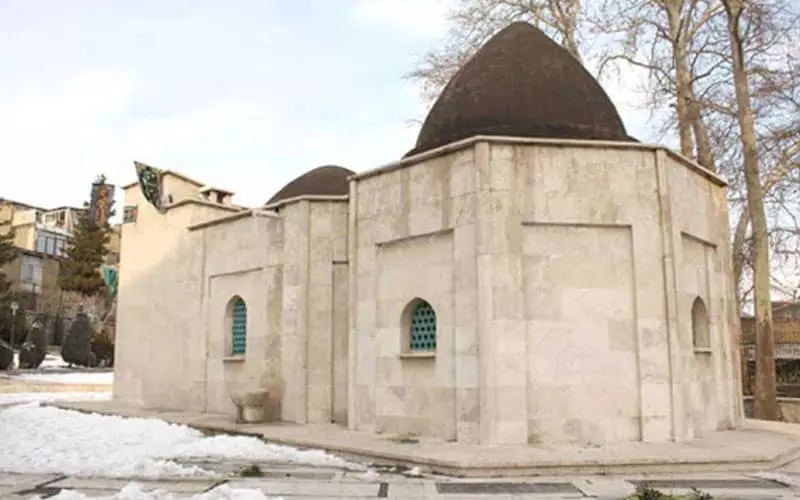
Jameh Mosque of Imam Hasan Askari (AS)
The Jameh Mosque of Imam Hasan Askari (AS), with a history dating back to the 5th and 6th centuries AH, is among Iran’s national monuments. Residents of Lavasan believe that Imam Hasan Askari (AS) personally ordered the construction of this mosque after spending a few days in Lavasan.
Imamzadeh Fazlollah (AS)
Imamzadeh Fazlollah (AS), located in the village of Naran in the Lavasanat region, is the brother of Imam Reza (AS) and one of the sons of Imam Musa Kazim (AS). Currently, the shrine has two iwans, one on the northern side and the other on the southern side. The shrine room has a quadrangular plan and is adorned with mirror work that turns into an octagon and then into a circle, leading to the dome. Due to heavy rainfall in the second half of the year, the shrine’s ceiling has a vaulted design. This historical monument was registered as a national heritage of Iran in 2003.
Historical Attractions in Lavasan
Dokhtar Castle
Dokhtar Castle, also known as Band Castle, is a registered national heritage located in the north of Bagh-e Jahan Village. Unfortunately, this castle has been lost over the decades, and its materials have been used for village buildings.
Hasarak Hill
Hasarak Archaeological Site, or Jaj Hill, is situated in the south of Golandook neighborhood in Lavasan city and is one of Iran’s national treasures registered in 1986.
Bagh Darreh Ancient Castle
Bagh Darreh Ancient Castle is another of Lavasan’s national treasures registered in 2003. Located in the north of Naran neighborhood, its history dates back to the Achaemenid and Sassanian periods.
Rahat Abad Bathhouse
Rahat Abad Bathhouse is located in Rahat Abad village and belongs to the Safavid and Qajar eras. It was listed as a national heritage of Iran in 2003. The bathhouse was built in a north-south direction, with some parts of it now destroyed. The dressing room, hot room, and treasury are different sections of this bathhouse. The materials used in Rahat Abad Bathhouse are rubble stone and gypsum mortar, although lime mortar is used in its interior structure.
Nazam al-Sultan House and Chenarek Tree
Nazam al-Sultan House and Chenarek Tree are situated in Golandook neighborhood in Lavasan city. This structure, dating back to the Qajar period, was listed as a national heritage on October 12, 1998.

Other Attractions in Lavasan
Among the sights of Lavasan, which are considered national treasures of Iran, are the ancient site of Sar Qabr Taj al-Din, the ancient hill of Nazemabad, the ancient hill and mansion of Tang-e Khané, the ancient hill of Jovek, the ancient hill of Sar Qaleh, the ancient hill of Suezgaran, the ancient hill of Shire Taze, and the ancient hill of Ghalyan (Frangis). Other hills such as the ancient site of Steppe Sowmehvar, the ancient hills of Goshvareh, the ancient hill of Kelabad, and the ancient hill of Morghi are also located in the Lavasan area, all of which are registered in the list of national heritage sites.
The Gabrisang or Persang Cemetery and the Cheshme-ye Do Barar Caravanserai are also among the attractions of this region worth visiting.
Vaziri Museum Cave
Vaziri Museum Cave is considered Iran’s first private museum cave, located in the heart of the mountains of Lavasan, and its artifacts are made of recycled materials. This museum was established in 2005 by the late Nasr Houshmand Vaziri, a first-class sculptor in the country. The museum’s collection includes a wide range of visual arts such as strange and unique sculptures made of different materials, celebrity busts, various chess sets from different eras, and more. The interior space of Vaziri Museum Cave consists of various sections such as sculpture workshop, handicraft workshop, visual arts gallery, etc.
Frequently Asked Questions
How many sections does Lavasan have?
Lavasan is divided into Lavasan Bozorg, Lavasan Kuchak, and Lavasan city, accommodating numerous villages within itself.
What activities are available at Latian Lake?
Fishing, nature walks, hiking in the lush hills, and exploring the surrounding villages are among the activities available in this area.
Why is it called Hooijeh Plain?
Hooijeh Plain or Garchal (Fire Pit) is considered one of the attractions of Afjeh Village, which apparently used to be under carrot cultivation in ancient times.
Which museum cave is located in Lavasan?
Vaziri Museum Cave is considered Iran’s first private museum cave, located in the heart of the mountains of Lavasan, and its artifacts are made of recycled materials.

